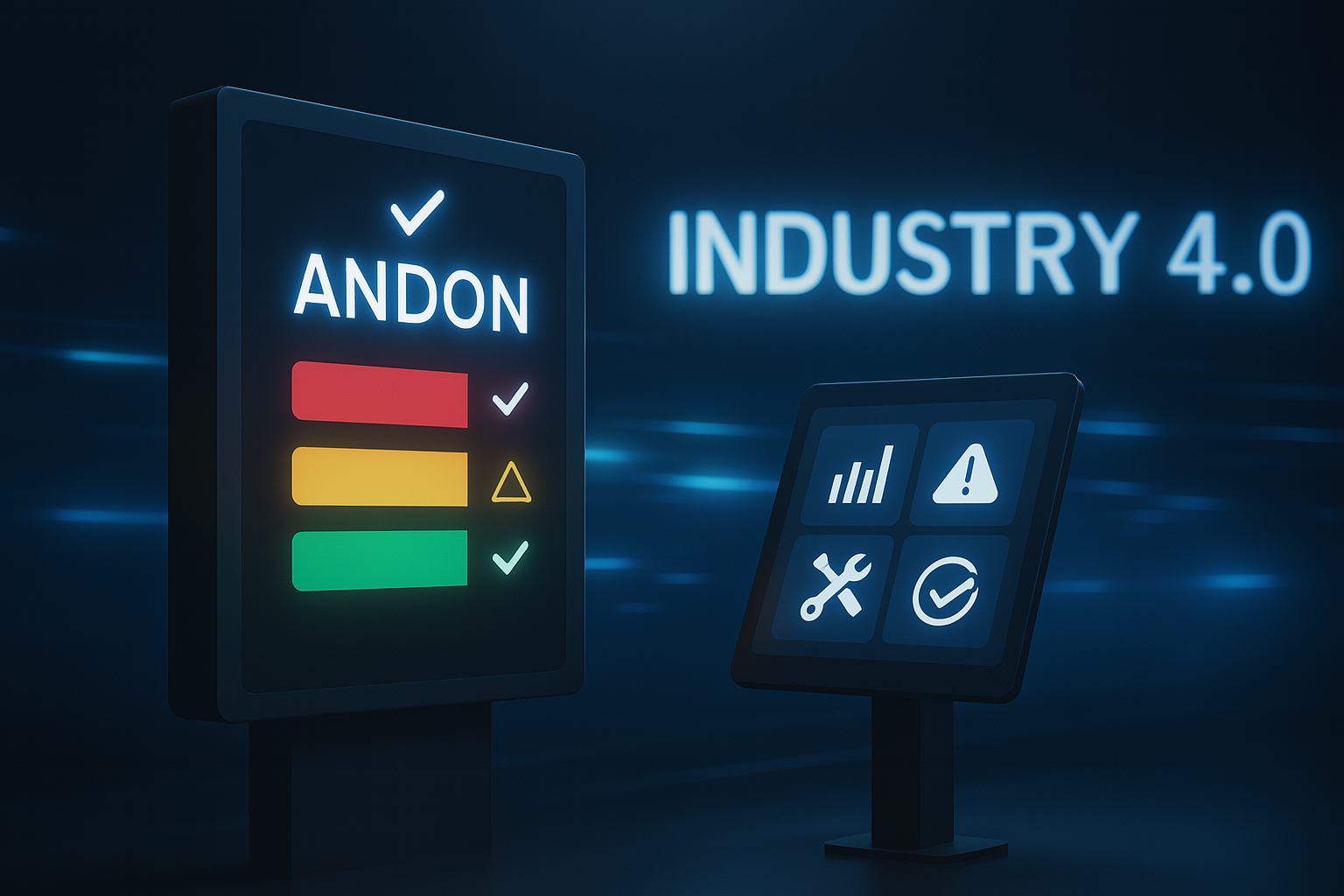
Andon systems, originating from Toyota assembly lines, have undergone a radical transformation with the arrival of Industry 4.0. These alert devices, once limited to cords and light signals, have become accessible and powerful digital solutions. Today, even manufacturing SMEs can implement these technologies that significantly improve responsiveness to production problems while generating valuable data for continuous manufacturing improvement.
The Andon system has its roots in Toyota factories in Japan. You've probably noticed those visual devices with green, yellow, and red lights in certain industrial environments - these are the most visible manifestation of traditional Andon systems.
In the original automotive assembly lines, the concept was simple yet revolutionary: each worker on a line sometimes consisting of up to 400 stations had a cord to pull in case of a problem. When an operator encountered a difficulty that could affect quality or block production, they pulled this cord, triggering a visual signal (usually light panels) that precisely indicated which station required intervention.
A dedicated team was then mobilized to quickly solve the problem. This approach allowed:
This industrial signaling system was subsequently adopted by the entire global automotive industry, with successive improvements such as replacing cords with buttons and adding digital screens indicating the affected station number.
Despite their obvious effectiveness, classic Andon systems presented several major drawbacks, particularly for smaller companies:
The physical infrastructure required a substantial investment in hardware: cords, buttons, light systems, wiring, and signage. For a manufacturing SME, the value/effort ratio was often unfavorable.
Furthermore, these traditional systems offered limited functionality:
You might wonder how such a fundamentally useful technology could remain inaccessible to many businesses. The answer lies in the complexity and cost of traditional infrastructure, which made these systems prohibitive for smaller structures.
By 2025, the situation has radically changed. The advent of Industry 4.0, characterized by the digitization of industrial processes, has transformed Andon systems into accessible, flexible, and powerful solutions.
The first major evolution concerns the hardware infrastructure. Today, an Andon system can be deployed with:
Gone are the complex and costly mechanical installations. A company can now equip all its workstations for a fraction of the historical cost.
This accessibility has allowed the use of Andon systems to extend well beyond assembly lines. Now, every workstation in the factory can benefit from this technology:
The old scenario where an operator had to physically find their supervisor, wait for their availability, then possibly find maintenance personnel is now a thing of the past.
Modern Andon systems have also evolved in how they communicate problems:
For example, a shipping operator can simply indicate via a touch interface that their label printer is no longer working. The system automatically identifies that this is an IT problem and directly alerts the IT team, without going through the traditional hierarchical chain.
The integration of Andon systems with industrial IoT offers many advantages that far exceed the capabilities of traditional systems:
Factory digitalization has allowed the applications of Andon systems to expand to various domains:
If the simplification of infrastructure and the improvement of alerts already represent considerable advances, it is the analytical aspect that constitutes the true revolution of modern Andon systems.
Unlike traditional systems that kept no record of incidents, current digital platforms record and analyze each event, transforming the alert system into a real tool for continuous improvement.
Companies can now access crucial data:
In essence, the modern Andon system functions as an internal ticket system, creating a valuable database for continuous improvement teams. The most frequent or time-consuming problems can be identified and targeted for optimization projects.
One of the most remarkable aspects of modern Andon systems is their ease of implementation. Unlike the complex installations of the past, deployment typically follows these simple steps:
Costs are essentially limited to the price of tablets and the initial system configuration. Moreover, these solutions are highly scalable:
This modular approach allows even the smallest companies to immediately benefit from the advantages of an Andon system, then evolve it as their growth and needs develop.
Return on investment typically manifests in the first 3 to 6 months of use, mainly due to:
The evolution of Andon systems perfectly illustrates how Industry 4.0 is democratizing technologies once reserved for large industrial groups. What was a major investment has become a "quick win" within reach of any manufacturing company.
These Andon systems in Industry 4.0 preserve the essence of Toyota philosophy - quickly drawing attention to problems to solve them efficiently - while adding the analytical power and flexibility of digital technologies.
For manufacturing SMEs, implementing an Andon system today represents one of the most accessible improvements with a high return on investment. Beyond the immediate improvement in responsiveness, these systems also constitute a first step toward a more connected factory driven by data.
Ultimately, what was once a simple alert signal has become a true nervous system of the modern factory, capable not only of signaling problems but also of actively contributing to the continuous improvement of production processes. Andon systems in Industry 4.0 thus represent a perfect example of how digitalization is transforming the fundamentals of industrial production.
Sign up to follow manufacturing news.